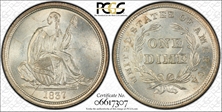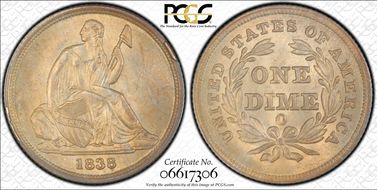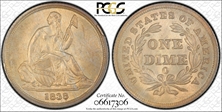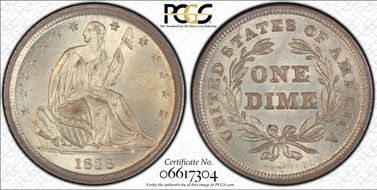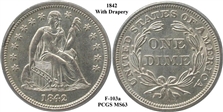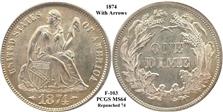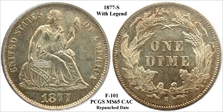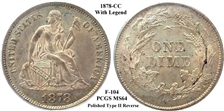Top 100 Liberty Seated Dime Varieties 的展示图片库
Mintage: 682,500 (Both date sizes)
Obverse Dies: 3 Known
Fortin Top 100 Seated Dime Varieties #1 - F-101c
The No Stars obverse shows the Christian Gobrecht rendering of the Thomas Sully design, while the reverse has a wreath with ONE DIME, thin long leaves with long stemmed closed berries and the legend UNITED STATES OF AMERICA. All design elements except the date were hubbed into the master die, a technological breakthrough for the time period. First coinage of this group was 30 brilliant proofs struck on June 30, 1837 at the direction of Mint Director, Robert Patterson.
Plate Coin: Fortin-101c, Bold luster highlists finest known example of shattered obverse and clashed dies variety.
Mintage: 682,500 (Both date sizes)
Obverse Dies: 3 Known
Fortin Top 100 Seated Dime Varieties #1 - F-101c
The No Stars obverse shows the Christian Gobrecht rendering of the Thomas Sully design, while the reverse has a wreath with ONE DIME, thin long leaves with long stemmed closed berries and the legend UNITED STATES OF AMERICA. All design elements except the date were hubbed into the master die, a technological breakthrough for the time period. First coinage of this group was 30 brilliant proofs struck on June 30, 1837 at the direction of Mint Director, Robert Patterson.
Plate Coin: Fortin-101c, Bold luster highlists finest known example of shattered obverse and clashed dies variety.
Mintage: 489,064
Obverse Dies: 1 Known
There are two known die pairings for 1838 New Orleans coinage. Both die pairings employ the same obverse die. The initial 30 specimens of 1838-O dimes were struck on May 7-8, 1838. An additional 367,434 of Ahwash 1 were struck between June and July 1838. The final group (Ahwash 2) was struck in January 1839.
Plate Coin: Fortin 101, Ahwash 1, Repunched O/O, Consistent Medium Golden and Bronze Toning on Obverse and Reverse, Flawless Surfaces, Originally Holdered As ICG65, CoinFacts Plate Coin for 1838-O date.
Mintage: 489,064
Obverse Dies: 1 Known
There are two known die pairings for 1838 New Orleans coinage. Both die pairings employ the same obverse die. The initial 30 specimens of 1838-O dimes were struck on May 7-8, 1838. An additional 367,434 of Ahwash 1 were struck between June and July 1838. The final group (Ahwash 2) was struck in January 1839.
Plate Coin: Fortin 101, Ahwash 1, Repunched O/O, Consistent Medium Golden and Bronze Toning on Obverse and Reverse, Flawless Surfaces, Originally Holdered As ICG65, CoinFacts Plate Coin for 1838-O date.
Mintage: 1,992,500
Obverse Dies: 8 Known
Working dies of 1838 through 1840 were created from the No Stars hub of 1837. Each working die had 13 individual stars hand punched resulting in variations in star placement and size. One obverse in 1838 features smaller stars from a punch intended for half dimes and is known as the Small Stars Obverse. The Stars Obverse type was struck at the Philadelphia during 1838 through 1840 and at the New Orleans mint during 1839 and 1840. For the 1838 Philadelphia date, eight different obverse dies have been identified. Many of the obverse dies are found today with important late die states where the die shows large die cracks that tranverse the obverse.
Plate Coin: Condition Census Gem
Mintage: 1,992,500
Obverse Dies: 8 Known
Working dies of 1838 through 1840 were created from the No Stars hub of 1837. Each working die had 13 individual stars hand punched resulting in variations in star placement and size. One obverse in 1838 features smaller stars from a punch intended for half dimes and is known as the Small Stars Obverse. The Stars Obverse type was struck at the Philadelphia during 1838 through 1840 and at the New Orleans mint during 1839 and 1840. For the 1838 Philadelphia date, eight different obverse dies have been identified. Many of the obverse dies are found today with important late die states where the die shows large die cracks that tranverse the obverse.
Plate Coin: Condition Census Gem
Mintage: Unknown
A single 1838 obverse die was clashed during its life resulting in the transfer of reverse wreath details to the area below Libertys right arm. This die clash was first attributed as partial drapery and the designation has remained popular with date and variety collectors.
Plate Coin: Fortin-108a, A Near-Gem That Boasts Copper-Gray and Light Green Patina.
A single 1841 obverse die was used to strike both Large and Small O transitional Closed Bud dimes in early 1841, probably January. The obverse is found well struck on the few high grade Closed Bud examples that exist. Reverse A is the left over 1840-O Reverse (A) which was previously shown in a late die state during its usage in 1840. In this final die state, Reverse A is badly cracked with numerous die cracks from the rim to the letters in the legend. Cherrypicking either an example of the Large or Small O Closed Bud can also be accomplished by studying either the obverse or the reverse die. Since the same obverse die was only used with the transitional reverses, its date, which is farther left than on any other 1841 obverse, can be an important diagnostic. The differences between an Open and Closed Bud Reverse is obvious in higher grades. In lower grades, one must examine the position of the lower left wreath leaf with respect to (U)NITED. See the photos above as a guide. I consider both the Large and Small O transitional Closed Bud dimes to be key coins in the Top 100 LIberty Seated Dime Variety set. The plate coin is currently the second finest known example of the 1841-O Large O Closed Bud transitional variety.
Mintage: 1,887,500
Obverse Dies: 7 Known
Seven different obverse dies have been identified for 1842 Philadelphia coinage, including the proof die. Segragating 1842 obverse dies is difficult due to minor differences in date position placement.
The 1842 plate coin variety (Ahwash 3) is always seen with a bold rim cud from Star 3 to Star 5. The date digits are heavily punched with the 84 digits touching. A faint die crack joins Stars 7 and 8 with Liberty's head. The reverse die features an abundance of die lines between the right rim and wreath. A large series of parallel die lines originate from the right rim into the letters ERICA of AMERICA. Another significant die line passes through the first S of STATES.
Plate Coin: Fortin 103a, Ahwash 3, Rim Cud at 10:00, Even White and Lustrous Example, Finding an Acceptable Upgrade has been Quite Difficult
All four date digits of the 1843 Repunched Date variety are strongly repunched downward. The reverse is perfect on this PCGS registry coin (the Brian Greer plate coin) but will soon exhibit die cracks as incremental coinage is produced.
Additional macro images and descriptions can be found at the www.seateddimevarieties.com website at the following link; http://www.seateddimevarieties.com/preview/1843_102page.htm
Mintage: 1,535,500
Obverse Dies: 12 Known
1852 dimes are easier to locate than the tougher 1851 date. Twelve obverse and fourteen reverse dies have been cataloged at Fortin''''s variety web-book at www.seateddimevarieties.com.
Plate Coin: Fortin 116, Repunched 52 Obverse Paired With Unlisted Reverse Die, Still Under Study, Incredible Toning and Strike For MS64 Graded Seated Dime
The 1853 Repunched Date obverse/reverse die pair comes in various die states. Early die state examples will show strong repunching on the 85 digits which will slowly diminish with die wear. On the reverse, die cracks are found from rim to top of letters STA(TES) and A(MERICA).
John McCloskey first published the 1853WA Repunched Date obverse in the March 1980 issue of the Gobrecht Journal.
Detailed macro images of the 1853 Repunched Date variety can be found at the www.seateddimevarieties.com website at following link; http://www.seateddimevarieties.com/preview/1853wa_107page.htm
A significantly doubled obverse die with the entire shield and gown lines above the pendant doubled EAST. Doubling is also clearly visible on Liberty's pole. The 185 digits are repunched. Repunching can be seen above the flag of the 1 digit, on the upper loop of the 8 digit and above the flag of the 5 digit. This doubled obverse die will be subsequently polished with complete loss of the date repunching. For additional details about the 1856 Small Date Doubled Die Obverse variety, see www.seateddimevarieties.com and the following link; http://www.seateddimevarieties.com/preview/1856sd_108page.htm
On the 1856-O Repunched Date Down variety, the final date punch has been repunched in a clockwise downward direction over the previous date punch. Significant traces of the previous date digits are visible below the 1 digit and above and within the 56 digits. Die chips are visible around Stars 3 through 6. The obverse die is rusted and generally found weakly struck. This PCGS registry coin is the finest known example of the Repunched Date Down variety known to me.
The date on 1873 No Arrows with Repunched Date appears to slope upward, however the tops of the digits are even with the base. The digits in the date exhibit obvious repunching. Repunching is seen at the bottom left of each digit. There is a diagonal die line in the lower right gown. Examples of the Repunched Date variety are typically seen with strong strikes including full heads. For more information and macro images, please visit www.seateddimevarieties.com website and the following link; http://www.seateddimevarieties.com/preview/1873nac3_103page.htm
The 1873 With Arrows Doubled Die Obverse variety was discovered by Kam Ahwash, but not published in his 1981 encyclopedia. This variety, with its spectacular die doubling within and to the right of the shield, is considered R-6 in problem free VF or better and is infrequently encountered, bringing a significant premium when located.
Locating a choice and original 1873 With Arrows DDO example will take patience and considerable effort. Presently, I am aware of three coins in AU or higher grade with fully original surfaces; one sits in the collection of a major dealer, and two others including this example. The registry set dime was purchased in December 2008 after years of searching for a high grade fully original specimen (that someone would sell!). My example has mint state details with lovely original grey, brown, green and even rose toning. The original toning may be the result of a small mark below (D)IME that kept the coin from being dipped and sent to TPGs for a mint state slabbing attempt even though PCGS recently gave the dime a certified grade of AU55. I believed the original toning to be more important than the reverse mark and wholeheartedly welcomed this rare doubled die obverse example into my reference collection. Additional information and macro images are available at www.seateddimevarieties.com website at the following link; http://www.seateddimevarieties.com/date_mintmark/1873wa_103page.htm
The 1873 With Arrows Doubled Die Obverse variety was discovered by Kam Ahwash, but not published in his 1981 encyclopedia. This variety, with its spectacular die doubling within and to the right of the shield, is considered R-6 in problem free VF or better and is infrequently encountered, bringing a significant premium when located.
Locating a choice and original 1873 With Arrows DDO example will take patience and considerable effort. Presently, I am aware of three coins in AU or higher grade with fully original surfaces; one sits in the collection of a major dealer, and two others including this example. The registry set dime was purchased in December 2008 after years of searching for a high grade fully original specimen (that someone would sell!). My example has mint state details with lovely original grey, brown, green and even rose toning. The original toning may be the result of a small mark below (D)IME that kept the coin from being dipped and sent to TPGs for a mint state slabbing attempt even though PCGS recently gave the dime a certified grade of AU55. I believed the original toning to be more important than the reverse mark and wholeheartedly welcomed this rare doubled die obverse example into my reference collection. Additional information and macro images are available at www.seateddimevarieties.com website at the following link; http://www.seateddimevarieties.com/date_mintmark/1873wa_103page.htm
Mintage: 2,940,000
Obverse Dies: 13 Known
The 1874 With Arrows Philadelphia date is common in all grades. More available in AU Mint State grades than the 1873 With Arrows date. To date, thirteen different obverse dies have been identified.
Plate Coin: Fortin 103, Repunched 74, White With Hint Of Light Gray Toning
Mintage: 10,350,700
Obverse Dies: 19 Known
1875 Philadelphia dimes are common in all grades including Mint State. It is expected that additional date position varieties will continue to surface.
Plated Coin: Fortin 107, Untoned and Very Choice Example of Extra 1 Digit In Denticles Variety, One of the Finest Examples of the Key MPD Variety for Liberty Seated Dimes.
Mintage: 2,340,500
Obverse Dies: 10 Known Only With Type II Reverse
The 1877 San Francisco date is difficult to locate in nice EF-AU condition. Greer considers the 1877-S date as "One of the most challenging common dates to locate". It has been speculated that significant melting of this coinage took place to supply silver for minting of Morgan silver dollars in 1878.
All 1877 San Francisco examples will be found with a Type II reverse.
Plate Coin: Fortin 101, Repunched 18 Digits, A Top 100 Variety, Light Rose/Gold Toning Throughout, Well Struck Gem
Mintage: 200,000
Obverse Dies: 1 Each Known With Type I and Type II Reverses
1878 Carson City dimes are found with well struck obverses, including Liberty's head. There are four known reverse dies; one being a Type I, the balance are Type II reverse dies. The three different Type II reverse dies all exhibit weakness in the left wreath due to polishing. The polishing or lapping of these reverse dies is most evident on Variety 104, the shattered reverse die from 1877.
Plate Coin: Fortin 104, Polished Reverse Die, Type II Reverse, Lustrous and Well Struck





















